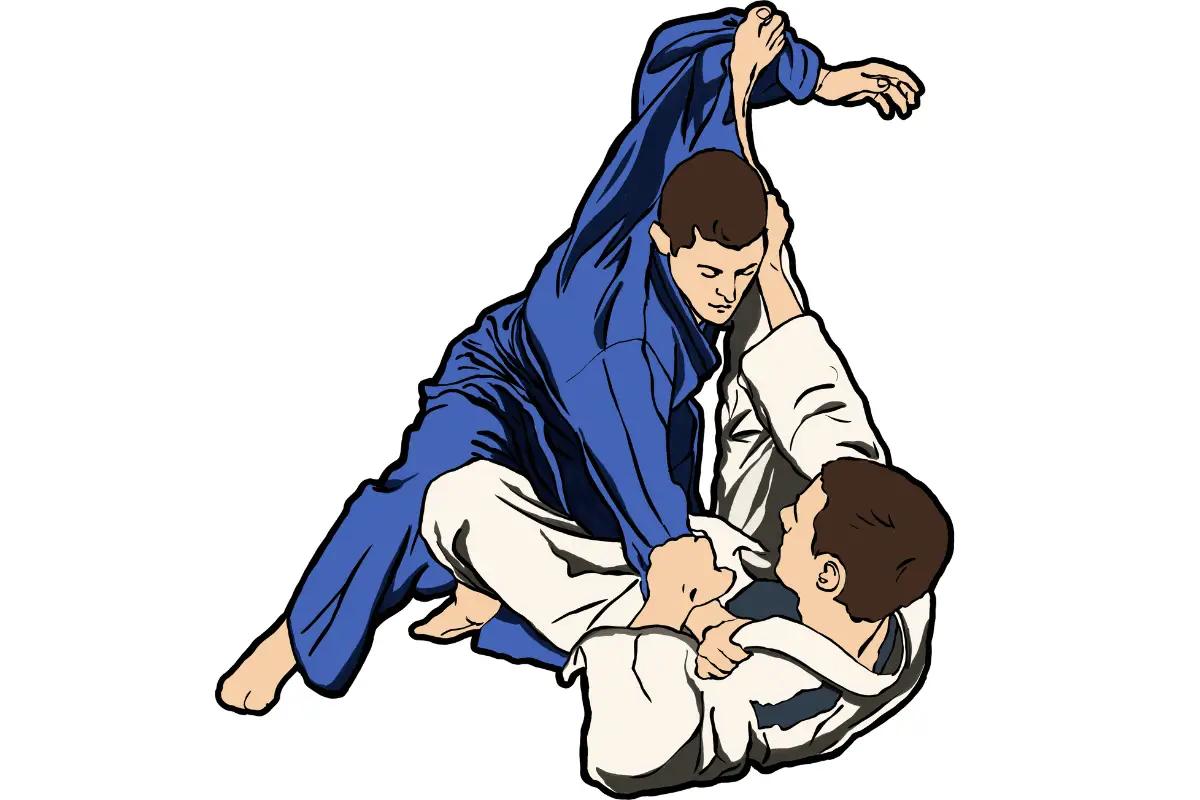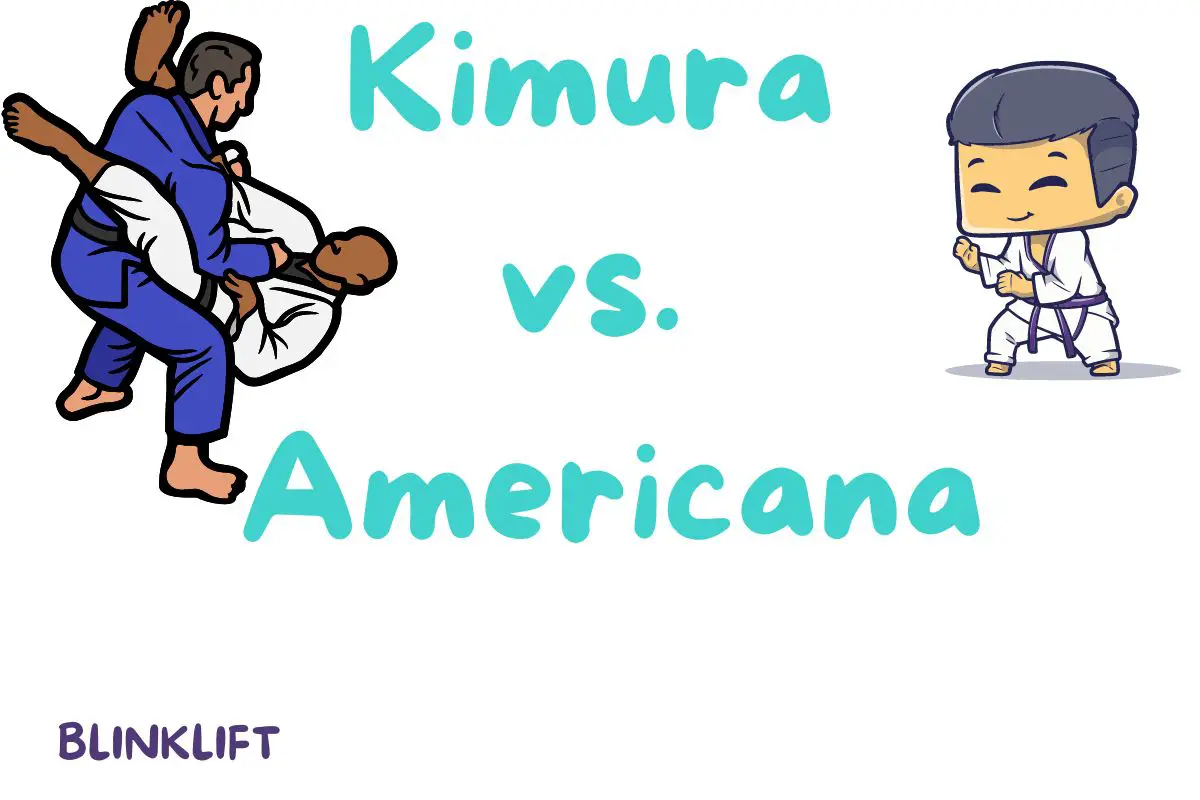BJJ is one of the most effective and applicable to real-life martial arts. If you decide to learn it, your eyes will be open to a new world, a world many people never see. Two popular submissions it teaches are the Americana and Kimura. Let’s see how they differ and what makes each unique.
The primary difference between the Kimura and Americana is where the opponent’s forearm will face when executing each one; if his forearm faces downwards, it’s a Kimura. But, if his forearm faces upwards, it’s an Americana. Also, the Kimura will typically be from the bottom, while the Americana will be from the top.
Now, you can execute both of them from all positions. That said, the way they’ll typically be performed is what I mentioned above.
And, you want to examine the opponent’s forearm. Again, his direction typically will dictate the submission.
And still, I’ve seen numerous variations of both techniques being performed both from the top and bottom with the opponent’s forearm facing the other direction. So the best solution I have for you is to gain experience slowly, and you’ll gain a natural sense of differentiating between the two.
Another way to do that is to read about each one and start to understand how each plays out.
What is the Kimura submission?
Learning to submit someone is what BJJ is all about. You can force someone to tap out by applying pressure in the right place and direction. If both are appropriate, you’ll push the opponent to surrender (tap out.) Let’s examine one of the ways to do that effectively, the Kimura.
The Kimura is one of BJJ’s most effective submissions, and it uses the Kimura grip (forearm pointing downwards.) It’s typically performed from the bottom position, but you can also do it from the mount and side control positions. It utilizes shoulder and arm pressure to force the opponent to tap out quickly.
Here’s how you perform it from the guard position (bottom):
- Pull the opponent toward you
- Ensure his hands are on the mat
- Grab his wrist (not forearm)
- Open your guard and twist your body
- Place your hand between his arm
- Lean backward
- Apply pressure
This is a relatively simple variation of the Kimura. You want to learn it first, as learning and performing can be more than straightforward. Eventually, it’ll motivate you to learn more and tweak small details to make you more capable of submitting people with this magnificent submission.
And if you want to master the Kimura from all positions, I wrote a complete guide about it; make sure to read it by following the link.
What is the Americana submission?
Now, let’s review the Americana. It’s one of these techniques you learn when you first start training, as you can execute it from all the top positions, and you don’t need as broad of a knowledge to do it effectively. Let’s examine some more details.
The Americana is one of BJJ’s simplest and most effective submissions from the mount and side control positions. It utilizes arm and shoulder pressure (forearm pointing up.) You first need to drive the opponent’s hand down and lock your hands around it while applying pressure.
You’ve likely heard of this technique before. You’ve at least watched someone else do it.
If you haven’t yet started to learn BJJ, what are you waiting for? It’s one of the most beneficial martial arts globally. And you can begin to attain all the benefits it attracts sooner than you think. If you want some examples of the many benefits you can attract by learning BJJ, follow this link.
To wrap up this section, the Americana is a submission you must learn. You can learn it whether you’re a black or a white belt. And you’ll be able to win more fights using it—soon after learning it.
Differences between the Kimura and Americana
Alright, now that we’re familiar with the basics of these two submissions: the Kimura and the Americana. Let’s go over what we all came here for; the differences between the two.
I know how similar they are. It can be more than difficult to differentiate between the two, and that’s totally fine. It’s pretty natural to get them mixed up when someone goes for an Americana from the bottom or Kimura from the top position.
But there are things you want to look out for to differentiate between the two. Alright, enough introduction—let’s dive into their differences.
Difference #1 – Forearm position
The first thing to look out for is the opponent’s forearm position. This is one of the best indicators of which submission the person is performing. That said, it’s not always true, as the Kimura demonstration you’ve seen previously in this article shows.
The opponent’s forearm position is the primary way to differentiate between the Kimura and Americana. If his forearm is pointing downwards, the submission is a Kimura. On the other hand, if his forearm is pointing upwards, it’s an Americana.
This is the first way to differentiate between the two submissions. Unfortunately, it’s also the one I use the most to distinguish between the two, although you’ll get a natural sense for that once you get yourself rolling.
Difference #2 – Positions most commonly used
Now, for the second difference between the Kimura and Americana. Both are very alike. However, you won’t see grapplers perform both from the same position.
Typically, if the submission is from the top, it’s an Americana. However, if the submission is from the bottom, it’s a Kimura. While you can perform both from all positions, you won’t see grapplers perform the Americana from the bottom and the opposite for the latter.

Of course, this is only a guideline. Ensure you pay attention to all differences before you reach your final conclusion.
Finally, you can get the Kimura from more positions. So, as a result, you’ll be able to execute it from almost all positions and in many different openings. However, there are not as many situations where you can go for the Americana. So, that’s another difference to look out for.
You can also see this difference in play in the two videos I showcased earlier in the article. Watch how each technique is performed from the positions commonly attributed to them.
Which is better, Americana or Kimura?
Both the Americana and Kimura are very effective. Likewise, it won’t be long before you learn them in your BJJ gym. You’ll also learn them in other martial arts, by the way. But, the primary fighting style that teaches them is BJJ. So, let’s compare them to see which is better:
The Kimura is more effective than the Americana because you perform it from more positions, and thus, you can finish more fights using it. On the other hand, the Americana can only be used in a small set of situations, primarily when you’re on top and have access to the opponent’s arm.
Nevertheless, learning both of these techniques will be critical to your long-term progression. They can be effective even against the more advanced grapplers.
Therefore, you want to learn them as soon as possible in your journey. But, the Kimura is more effective against both beginner and advanced BJJ trainees, so emphasize mastering it—if you can.
Final words
Alright, you’ve made it to the end of this article. First, I want to show my dearest appreciation for investing your attention in this website. Likewise, you’ve invested your focus and concentration in learning more about the beautiful art of Jiu-Jitsu. Your will to learn will get you far ahead.
Both the Kimura and Americana are two highly effective submissions. They both utilize pressure on the opponent’s arm and shoulder to force him to tap out quickly. However, while one is performed from the top positions, the other is from the bottom.
This is just a rule of thumb. While that’s primarily the case, there are various exceptions.
You want to learn both these submissions when you start your training if you wish to see more success early on. Likewise, you can use the Kimura and Americana to submit more advanced grapplers, so they’re excellent all-around submissions.
You’d also enjoy reading these posts if you enjoyed this article:

